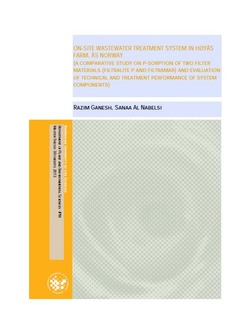| dc.description.abstract | Norway has endorsed strict regulations regarding wastewater discharge also in rural areas. In
areas defined as vulnerable i.e. most inland area the phosphorus (P) discharge limit is 1 mg P/l or
90% removal. Both package treatment plants and nature based systems (constructed wetlands,
soil infiltration) are used. Constructed wetlands or filterbed system (wetlands without
macrophytes) have excellent purification performance, but require a large area according to
current guidelines resulting in large investment costs. When using the phosphorus sorbing
material Filtralite P, leaching of calcium in the early stage of the system may clog outlet pipes or
form a white layer of CaCO3 at the discharge point. The lost calcium may also reduce the
longevity of the systems P-removal. At Høyås farm in Ås municipality a compact filter bed
system with post polishing sand filter to trap the leaching calcium has been built. A compact Pfilter combined with a polishing sandfilter has not been tested in Norway before. Two different Psorbing materials Filtramar and Filtralite P are tested and compared in the two 4m3
P-filter units
of the system. to find the maximum phosphorus retention capacity in order to increase the life
time and to reduce the investment cost.
Samples were collected during the first month of system operation in October 2012. Samples
were taken at an interval of around two weeks. Samples were analyzed for pH, conductivity
BOD5 (mg/l), COD (mg/l), total phosphorus (mg/l) and orthophosphate (mg/l). In addition a
batch experiment has been conducted to find the phosphorus sorption capacity of Filtralite P and
Filtramar.
The Batch experiment results showed that the sorption isotherms of Filtralite P and Filtramar had
different behaviors at high initial concentrations (50-480 ppm) and at low initial P concentrations
(0-50 ppm). With an initial concentration of 480 ppm, Filtramar (shellsand) had a P sorption
capacity of 8.22 g P/kg, while Filtralite P was found to have a P sorption capacity of 1.23g P/kg.
At low initial concentrations comparable to real wastewater concentrations Filtramar (shellsand)
had a P sorption capacity of 149 mg P/kg, while Filtralite P was found to have a P sorption
capacity of 476 mg P/kg. Thus at lower initial concentrations of phosphorus, Filtralite P had
higher P-sorption capacity than Filtramar did. The use of Langmuir equation to calculate the
maximum sorption capacity and the saturation points of the filter materials showed that Filtramar
had life time (26.2 years) ten times more than service life of Filtralite P (2.45 years). However it is not wise to determine replacement time of filter materials based on batch experiments results
only. Batch experiments can only be used to compare and rank filter materials according to their
phosphorus retention capacity and not for estimation of their life time.
The overall removal of the Høyås treatment system in its first three months of operation was 90%
BOD5 removal, 76% COD removal, 98% total phosphorus removal and 99% orthophosphate
removal. The results meet or exceed current discharge limits for the recipient with eutrophication
risk and user interests.
Insulation of bio-filter and sand filter by tree bark is a good solution to protect from frost but it
leaches organic substances and produces color in wastewater and that may increase COD in the
effluents and also block P-sorption sites of the filter media. The bark should be replaced. | no_NO |
